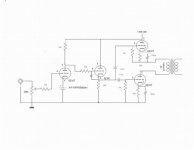i have read that cathode follower stages have a high damping factor, which makes for much better bass response. i am trying to work out the best line stage for my kt88 based se amplifier.in my line stage / preamp would it be a good idea to place a cathode follower after a common cathode stage to improve the damping factor.
any help appreciated
cheers
soundbadger
any help appreciated
cheers
soundbadger
Damping factor is only relevant when driving a loud speaker or other transducer. This is simply the ratio of load impedance to source impedance.
Example: An amplifier has a source impedance of 0.8 ohms, and is driving an 8 ohm load speaker, therefore the damping factor is 8/0.8 or 10..
All you care about here is a sufficiently low source impedance to drive your load without adding distortion and to prevent noise pick up from being an issue. Choose a tube for your line stage that has a fairly low plate resistance.
Example: An amplifier has a source impedance of 0.8 ohms, and is driving an 8 ohm load speaker, therefore the damping factor is 8/0.8 or 10..
All you care about here is a sufficiently low source impedance to drive your load without adding distortion and to prevent noise pick up from being an issue. Choose a tube for your line stage that has a fairly low plate resistance.
Output tubes can have a significant amount of input capacitance. This will act as a low pass filter with the preceding stages Zout. So, the lower the driver stages Zout the wider the bandwidth of the amplifier.
It is not always needed though. Really depends on the rest of the design.
Yes, a Cathode follower will always have a lower output impedance than the same tube as a common cathode. However it takes a lot more voltage to drive a cathode follower.
It is not always needed though. Really depends on the rest of the design.
Yes, a Cathode follower will always have a lower output impedance than the same tube as a common cathode. However it takes a lot more voltage to drive a cathode follower.
soundbadger said:i have seen a few schematics that have a cathode follower between the line stage valve and the power valve,,, i gather that this effectivly lowers the output resistance of first valve... could someone explain when it is necessary to do this..
cheers
soundbadger
I do this in my designs for a couple of reasons. With finals, the Ci + Cmiller + Cstray is higher than it is for the small signal types. The control grid won't see the true signal level until this input capacitance is fully charged. This is the slew rate problem. It takes current to charge capacitance, and the faster the rate of charge, the greater the required current. A cathode follower grid driver can source that current to avoid slewing at the upper end.
It also makes for convenient fixed bias without the usual coupling capacitor. It's a good idea to eliminate that since a coupling capacitor will charge to some negative voltage when the inevitable transient turns on the parasitic grid/cathode diode (this is how Class C amps derive most -- if not all -- of their operating bias). That extra negative bias can move the finals into a less linear part of the characteristic. Even if you don't actually hear a clip, this can cause an overall sonic degradation.
Finally, the Zo of the driver + the input capacitance makes an LPF. Since this capacitance is typically large, getting the Zo of the driver down improves the high frequency performance.
I guess I am confused: Are we talking line stage/pre-amp or power amplifier input/driver stages? (output tube driver stages) I'm quite literal minded so when I read pre-amp/line stage I naturally assume it isn't actually the (final) driver stages in a power amplifier we are talking about.
Hi
Just a thought from a newbie. If you use a commomn cathode
driver followed by cathode follower with the same type of tube,
using the same value resistor to load the cathode as your first
stage used to load the plate you take care of getting your
voltage to drive the follower, they can be direct coupled, cancell
each others distortion, and since they work antiphase, draw costant current to boot. I just built an amp using this idea.
Got the idea from John Broskie,s Tube cad journal
Just a thought from a newbie. If you use a commomn cathode
driver followed by cathode follower with the same type of tube,
using the same value resistor to load the cathode as your first
stage used to load the plate you take care of getting your
voltage to drive the follower, they can be direct coupled, cancell
each others distortion, and since they work antiphase, draw costant current to boot. I just built an amp using this idea.
Got the idea from John Broskie,s Tube cad journal
Attachments
- Status
- This old topic is closed. If you want to reopen this topic, contact a moderator using the "Report Post" button.
- Home
- Amplifiers
- Tubes / Valves
- cathode follower -- damping factor (HELP please)
